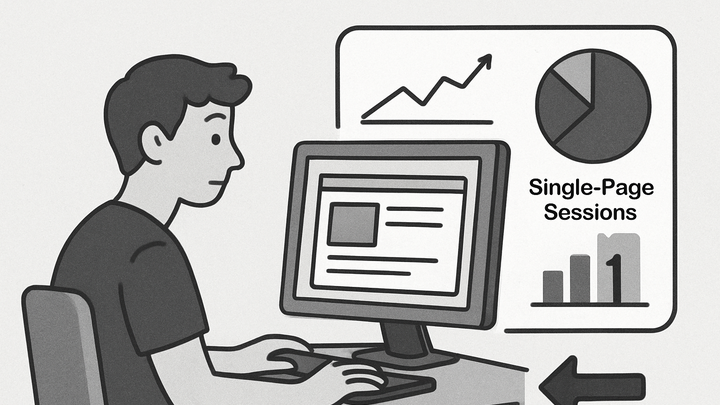Published on 2025-06-28T05:26:13Z
What Is a Single-Page Session? Examples in Analytics
In web analytics, a Single-Page Session is a session in which a visitor views a single page and leaves without loading additional pages during that visit. It often aligns with the concept of a bounce on traditional pageview-based platforms, but in modern analytics tools, it may be measured differently. Single-Page Applications (SPAs) can complicate this metric, since route changes within the app do not trigger full page reloads. Tools like GA4 use event-driven tracking to capture user engagement beyond pageviews, while privacy-focused solutions such as PlainSignal offer cookie-free session tracking. Understanding single-page sessions helps you interpret bounce rates, engagement metrics, and the overall quality of user interactions on your site.
Single-page session
A session where a user interacts with only one page load, with no additional pageview events during their visit.
Overview of Single-Page Sessions
This section introduces the concept of single-page sessions and explains its significance in web analytics.
-
Core concept
A Single-Page Session occurs when a user visits one page and does not trigger another pageview event before ending the session, highlighting visits where no additional pages are loaded.
-
Traditional bounce
Historically equated with a bounce in Universal Analytics, where a session with one pageview and no interactions is counted as a bounce.
-
Modern interpretation
In event-driven analytics, engagement events can reclassify sessions with interactions as engaged, even if only one page loaded.
-
Calculation and Metrics
How analytics tools measure and report single-page sessions.
-
Pageview-based tracking
In Universal Analytics, single-page sessions lead to bounce rate calculations, since only one pageview is recorded.
-
Bounce rate formula
Bounce Rate = (Single-Page Sessions) / (Total Sessions).
-
-
Event-driven tracking
GA4 and PlainSignal use events to capture engagement, affecting how single-page sessions are reported.
-
GA4 engagement rate
GA4 counts sessions as engaged if a user triggers engagement events, so a single-page session with events may not be classified as a bounce.
-
Cookie-free sessions
PlainSignal tracks sessions without cookies by logging first and last event timestamps, ensuring privacy while preserving session data.
-
Implementation Examples
Code snippets and configuration for PlainSignal and GA4 to track single-page sessions.
-
PlainSignal (cookie-free simple analytics)
To implement PlainSignal on your site, include the following snippet in the head of your HTML:
-
Tracking snippet
<link rel="preconnect" href="//eu.plainsignal.com/" crossorigin /> <script defer data-do="yourwebsitedomain.com" data-id="0GQV1xmtzQQ" data-api="//eu.plainsignal.com" src="//cdn.plainsignal.com/plainsignal-min.js"></script>
-
-
Google analytics 4 (event-driven)
For SPAs in GA4, use gtag.js or Google Tag Manager to fire page_view events on route changes. Example with gtag.js:
-
GA4 spa configuration
gtag('config', 'G-XXXXXXXXXX', { 'send_page_view': false }); // On route change gtag('event', 'page_view', {'page_path': '/new-page'});
-
Best Practices and Considerations
Tips for accurate measurement and interpretation of single-page sessions.
-
Ensure interaction events
Add custom events (scroll, clicks, time on page) to distinguish engaged single-page sessions from true bounces.
-
Monitor session timeout
Adjust session timeout settings to reflect realistic user inactivity periods, preventing premature session endings.
-
Understand tool differences
Recognize that different analytics platforms calculate sessions differently; compare apples to apples when benchmarking.
